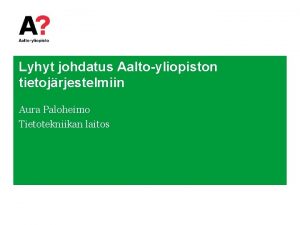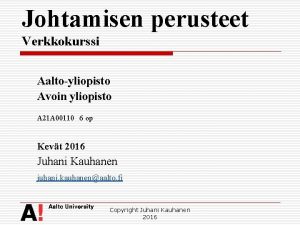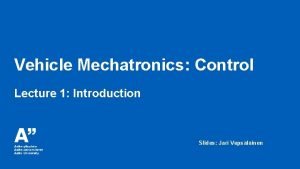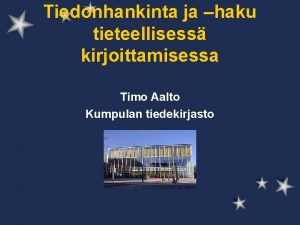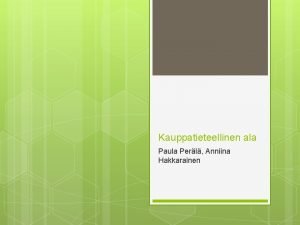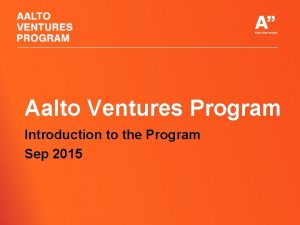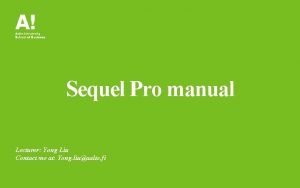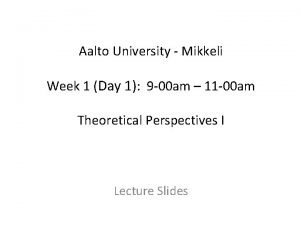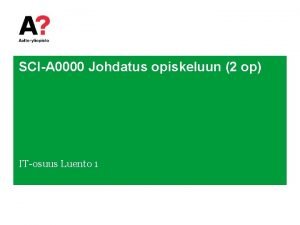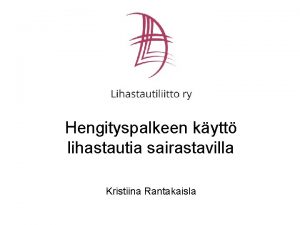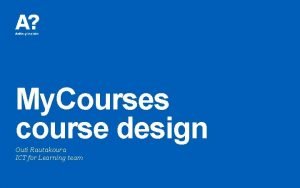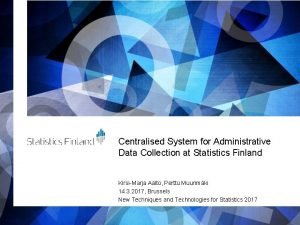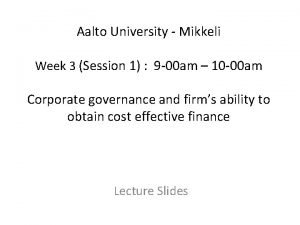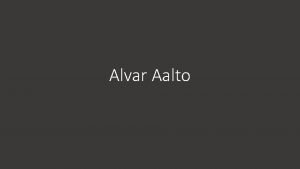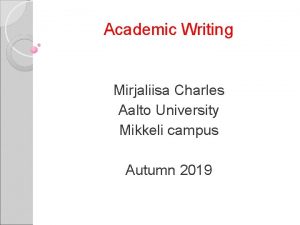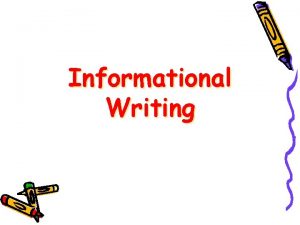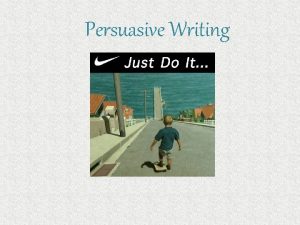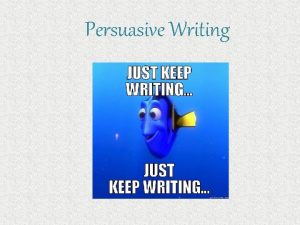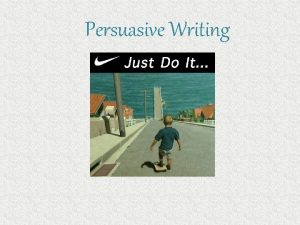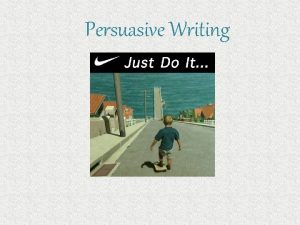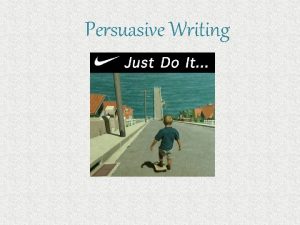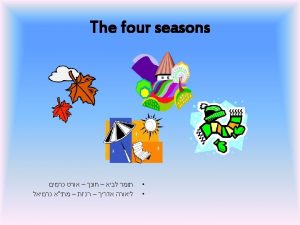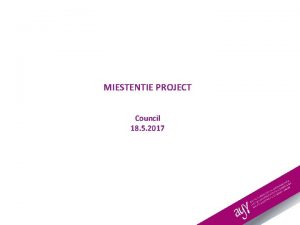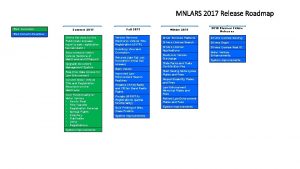LCA1010 Writing Inspirations Summer 2017 H 01 Aalto


























- Slides: 26

LCA-1010 Writing Inspirations, Summer 2017, H 01 Aalto University School of Arts, Design and Architecture

Session 3 Homework: 1) Exhibition Description 2) Writing Activity 2 • An exercise on Transitional Words and Phrases • Artist Statement Ø General discussion of findings & analysis of samples Ø Guidelines and getting started with your own statement • Sentence Patterns & Variety 29. 10. 2020 2

Intro to Transitional Words and Phrases (to be done at home!) • In My. Courses Session 2, • Open the handout ’An exercise on transitional words and phrases’ • Complete the essay with the given linking words. You can use one word a few times. 29. 10. 2020 3

Your artist/designer statement

Discussion ”Why would I want to write an artist statement? ” • to clarify your own ideas about your work: a general introduction of your work as an artist/designer, • the what, how, and why of your work, from your own perspective • to have a base for a proposal for an exhibition or project • to fill a requirement for scholarships, grants/funding, teaching positions, or admission to school • to have a good source of info for art reviewers, journalists, and reporters • to introduce your work to the buying public 29. 10. 2020 5

Discussion ”My work speaks for itself, doesn’t it? ” Consider your audience! Remember, potential employers or buyers may not have access to your artwork. Your statement may be the only way of making a good, first impression. 29. 10. 2020 6

Discussion ”Language cannot adequately describe my art, can it? ” Yes, it can! Remember, every time you talk or think about your artwork, you experience a relationship between words and your art. 29. 10. 2020 7

Analysis of your findings in small groups (of 2 -3 people) • Analyze the core elements (what is covered? ) • Identify the reasons for these being great/bad models (style, length, content? ) • Briefly report to the whole class. • Would you want to imitate the style of any of these statements? • If yes, why? If not, why not? 29. 10. 2020 8

Artist Statement Do’s and Don’ts 1/2 Do’s Don’ts • Use specific language that • Vague references (to art, anyone can understand literature, music, etc. ) that (conversational style)! require specific knowledge • Your statement is about you • Arrogant, arcane, bloated, elitist, egotistical, or – personalize it and write in the 1 st person; i. e. pompous wording; occasionally, make ”I” patronizing ”You” statements! statements 29. 10. 2020 9

Artist Statement Do’s and Don’ts 2/2 Do’s Don’ts • Explain the connection • Compare yourself to other between your art and the artists (”Like Jackson medium you are using Pollock, I used …”) • Give your audience the • Instruct your audience on option to agree or disagree how to see, behave, feel, with you. respond to your art, dictate interpretations. 29. 10. 2020 10

Other general guidelines: 1. Start off with a bang! Boring: ”My work is” ”In my work” • Stand out from the pack! • Start differently! 29. 10. 2020 11

Other general guidelines: 2. Less is more • Nobody wants to read a novel to get a gist of your work! • Keep it short and sweet! (3 paragraphs? ) 29. 10. 2020 12

Other general guidelines: 3. Learn to love the language • Maximize your impact with unique, fascinating verbiage! • Use both long and short sentences; • rather active than passive voice; • onomatopoeia. > Thesaurus. com; Dictionary. com; Etymonline 29. 10. 2020 13

Other general guidelines: 4. The words should match the work • Use verbs and adjectives that really match the qualities of your artwork! >This will create a statement that both excites and informs. 29. 10. 2020 14

Other general guidelines: 5. Get a second opinion • Do NOT publish or send out your statement before someone else has looked over it. Ø How well do the words actually match your work? • Try reading it out loud > a sense of the rhythm and flow!? • You want to have a fresh, creative, professional and accessible statement! 29. 10. 2020 15

Artist Statements/ Getting Started/ ’Assembling the Ingredients’ • In My. Courses Session 3, open the link to Molly Gordon’s website on Artist Statements: • http: //www. mollygordon. com/resources/marketingres ources/artstatemt/index. html • http: //www. theabundantartist. com/how-to-write-anartists-statement-that-doesnt-suck/ • http: //www. artstudy. org/art-and-designcareers/sample-artist-statement. php 29. 10. 2020 16

Artist’s Statements/ Getting Started/ ’Assembling the Ingredients’ • First paragraph. Begin with a simple statement of why you do the work you do. Support that statement, telling the reader more about your goals and aspirations. • Second paragraph. Tell the reader how you make decisions in the course of your work. How and why do you select materials, techniques, themes? Keep it simple and tell the truth. • Third paragraph. Tell the reader a little more about your current work. How it grew out of prior work or life experiences. What are you exploring, attempting, challenging by doing this work. http: //www. mollygordon. com/resources/marketingresources/artstatemt/index. html 17

Sentence Patterns & Variety • Shall we analyze our own writing style a bit and improve it by using a variety of sentence patterns? 29. 10. 2020 18

Sentence Patterns & Variety • In its simplest form, a sentence in English has two parts: • a subject + a verb that express a complete thought when they are together • Marvin slept. • Dogs bark. • A clause = combination of a subject and a verb 29. 10. 2020 19

Sentence Patterns & Variety • Two kinds of clauses: • Independent clause: a subject + verb that make a complete thought Ø can stand on their own and make sense Ø Marvin slept. • Dependent clause: a subject + verb that do NOT make a complete thought Ø always need to be attached to an independent clause Ø Although I am curious, 29. 10. 2020 20

Sentence Patterns & Variety • Four Basic Sentence Patterns • Pattern 1: Simple Sentence • One independent clause (S+V): Ø I refuse. 29. 10. 2020 21

Sentence Patterns & Variety • Pattern 2: Compound Sentence • Two or more independent clauses. • Connectors with a comma, the FANBOYS: for, and, nor, but, or, yet, so • Connectors with a semicolon and comma: however, moreover, nevertheless, nonetheless, therefore Ø Mr. Potato Head eats monkeys for breakfast every day, but I don’t see the attraction. Ø Eating them makes him happy; however, he can’t persuade me. 29. 10. 2020 22

Sentence Patterns & Variety • Pattern 3: Complex Sentence • One independent clause PLUS one or more dependent clauses. Ø He recommends them highly because they taste like chicken when they are hot. Ø Although I am curious, I am still skeptical. 29. 10. 2020 23

Sentence Patterns & Variety • Pattern 4: Compound-Complex Sentence • Two or more independent clauses PLUS one or more dependent clauses. Ø Mr. Potato Head said that he would share the secret recipe; however, if he does, Mrs. Potato Head will feed him to the piranhas, so we are both safer and happier if I don’t eat monkeys or steal recipes. 29. 10. 2020 24

Sentence Patterns & Variety • In need of more variety for your sentence patterns in your Artist’s Statement? • Read your own Artist/ Designer Statement – draft. • Favor one particular pattern? • Try to revise a few sentences using a different pattern. • See the handout ‘Strategies for varying sentence structures’ in My. Courses Session 3. 29. 10. 2020 25

Homework for Thursday: 1) Write your first draft of the Artist Statement (three (3) paragraphs/ 200 + words) and bring it to class on Thursday. 2) Bring a copy of your CV (if you have one) to work on during next class. If you don't have one, google for some samples of CVs in your own field. 29. 10. 2020 26
 Pltw summer training 2017
Pltw summer training 2017 Aalto university school of engineering
Aalto university school of engineering Aalto eduroam
Aalto eduroam Avoin yliopisto aalto
Avoin yliopisto aalto Aalto eduroam
Aalto eduroam Aalto code of conduct
Aalto code of conduct Kari tammi aalto
Kari tammi aalto Mot sanakirja aalto
Mot sanakirja aalto Noppa aalto
Noppa aalto Aalto yritysjuridiikka
Aalto yritysjuridiikka Aalto kauppatieteet pisterajat
Aalto kauppatieteet pisterajat Aalto venture program
Aalto venture program Mycourses aalto
Mycourses aalto Mari-anna suurmunne
Mari-anna suurmunne Sequel
Sequel Key windows
Key windows Aalto university mikkeli
Aalto university mikkeli Into aalto mikkeli
Into aalto mikkeli Noppa aalto
Noppa aalto Keuhkon osat
Keuhkon osat Sisu aalto hops
Sisu aalto hops My courses ict
My courses ict Secclo aalto
Secclo aalto Sphere of influence
Sphere of influence Ava aalto
Ava aalto Aalto university mikkeli
Aalto university mikkeli Aaltopro
Aaltopro


